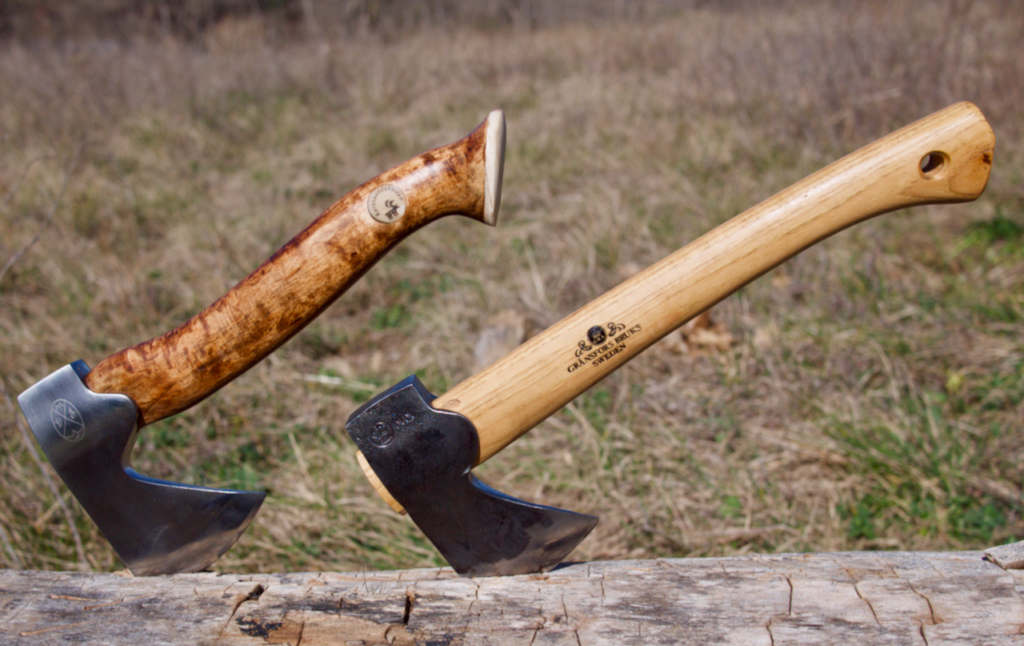Are you concerned about how to use a survival axe in a crisis? You’re in the right place!
This ultimate guide will provide you with all the essential knowledge you need to know about using an axe in dangerous or emergency situations. Get ready to learn how to stay safe and protect yourself by mastering the art of using a survival axe with confidence!
Survival axes are some of the most versatile tools you can carry with you in emergency situations. Their sharp blades and sturdy construction make them ideal for cutting firewood, making shelter, and building survival tools like spears and bows. By crafting a survival axe from natural materials, you can easily build a tool that will serve its purpose even in the harshest environments.
This guide will provide you with the information you need to understand the value of a good axe, how to select one for your particular needs, and how to use it correctly in emergency situations. In addition to discussing basic axe safety, this guide will cover topics like fire making techniques, shelter-building strategies, and how to sharpen an axe quickly using natural resources. By using this knowledge along with skills acquired from practice or formal instruction, you can ensure that your next outdoor adventure or stay outdoors is both safer and more enjoyable.

Brief overview of the importance of survival axes in emergency situations
Survival axes are indispensable tools in emergency preparedness and crisis situations. They provide a way to collect and transport essential items — such as firewood, water, food — and a variety of other tasks that can help save lives. In addition to hammers, saws, shovels, and even knives, these versatile tools can be used in multiple ways to improve the chances of survival.
A well-equipped survivalist/prepper should always keep at least one high-quality axe in their toolbox for any emergency situation. From chopping wood for campfires to cutting branches or clearing trails, the functionality of an axe is unparalleled for tackling rustic tasks. Meanwhile, their lightweight design makes them easy to carry over long distances or difficult terrain on foot.
In addition to their utility as a tool, an axe provides comfort during extreme situations by giving its user the confidence that they can survive if need be only with what they have on hand — this is especially true for SHTF scenarios where other supplies may not be available. Whether preparing for natural disasters or being stranded in the outdoors due to sudden events, having an axe with you can provide much-needed assurance that you will get through it alive and intact.
Choosing the Right Survival Axe
Choosing the right survival axe for your emergency situations is important for ensuring you have the best tool to aid in any situation. When selecting an axe, there are a few main factors to consider. The size of the axe, the weight of the head, and the type of handle all need to be taken into account.
Size: The size of the axe is determined largely by its length and width. Generally speaking, a larger axe is better suited for heavier tasks such as splitting wood or splitting logs, while a smaller axe is more suitable for finer work such as dressing branches or chopping kindling. It’s important to choose an axe that suits your intended tasks — one that is too large can be unwieldy and one that is too small may not provide enough power to get through hard wood.
Weight: The weight of an axe head will determine how much force you’ll need to exert when cutting or chopping with it. A heavier head will result in more precision and will carry more momentum when swinging it; however, it can also cause fatigue if used for long periods of time or for repetitive tasks. It’s best to go with something light enough that you can control easily yet heavy enough that it won’t get stuck in your material when applying pressure.
Handle: The design of the handle needs to provide good grip and comfort when holding it whether you’re using an established grip or striking with full force on tough material using a chopping block as backstop. Some handles are designed to fit smaller hands while others are suitable for larger ones — choose according to your own body frame so you don’t end up causing fatigue and soreness from overuse due them being ill-suited for your hand size. Additionally, handles made from materials such as metal will last longer than those made from plastics but may require extra insulation in extreme weather conditions due their tendency to become extremely cold quickly.
Factors to consider when choosing a survival axe
It is important to choose the right type of axe for different emergency situations. Understanding the factors involved in choosing a survival axe will help you choose the one that better fits your needs. The following are some key points to keep in mind when selecting an axe for your preparedness and survival kit.
Size: The size of the axe should depend on what kind of job you expect it to do and how much weight you are comfortable carrying. An overall length of 13-19 inches is considered suitable as it allows easy maneuverability and maneuverability and still delivers some power when needed. Additionally, consider the size of handle too as having a durable, comfortable fit can make a difference in performance and usability.
Weight: Heavier axes deliver more power but are harder to wield, whereas lightweight ones may be better in terms of accuracy. A suitable range is between 1.5-2 pounds depending on your strength and comfort level, so check out the available options before making your purchase decision.
Blade Grind: Choosing between choil shapes and edge angles can be overwhelming without prior knowledge and experience in using axes or knives; however, any grind that strikes a good balance between sharpness (edge retention) durability (resistance to dulling) should suffice for most general purpose needs such as chopping, cutting, splittingetc.. Bearing this mind will help narrow down your search efficiently whilst ensuring maximum practicality with every task that you may face outdoors or indoors.
Blade Material: Common materials used by manufacturers include stainless steel, carbon steel, cast iron or titanium alloys; however when it comes to survival equipment stainless steel is considered ideal due to its high corrosion resistance along with affordability factor making entry level surveillance equipment cost effective too. Therefore try examining available models made from stainless steel in order get value for money moving forward with this purchase completely confident that life saving tool performs optimally when put into action unexpectedly during emergencies like bushcraft, camping amongst numerous others.
Essential Skills for Using a Survival Axe
In order to effectively and safely operate a survival axe in an emergency situation, it is important to develop several key skills:
-Sharpening: Properly maintain the blade of a survival axe by periodically sharpening it. Use specialized tools designed for sharpening an axe to avoid excessively damaging the blade.
-Splitting: Learn specific techniques for splitting wood using a survival axe. Doing so helps conserve firewood and also makes building shelters more efficient in emergencies.
-Chopping: Develop proper methodologies for chopping down trees in case you are ever in need of firewood or lumber for constructing a shelter during an emergency situation. Utilize the best techniques for safely hitting and cutting through branches or trunks of trees.
-Felling Trees: Acquire any needed permits before attempting to remove trees from their natural environments, and gain necessary training methods such as identifying tree species, topography, and potential drop points. Awareness of potential danger from trees or limbs falling on people is also essential when felling large trees with a survival axe.
-Tool maintenance: Regularly inspect the head, edges, haft (handle), fetlock rings (shoulder rings that secure the handle), wooden wedges between them, and surrounding hardware on your survival axe’s handle to ensure complete safety while using it during an emergency.
Proper grip and stance
It is important to assume an effective and safe stance when wielding a survival axe for potential emergency situations. There are two primary approaches to doing this; the open-stance and the closed-stance. The open-stance involves holding the axe such that you are pointing towards your target with your feet shoulder-width apart, while in the closed stance, the axe should be held parallel to your stance and both feet should be lined up with your shoulders. Regardless of which stance you adopt, make sure to keep your arms close to your body and keep an eye on all of your surroundings including potential obstacles.
When it comes to gripping the handle of a survival axe, there are a couple of techniques. The first is called “power grip”. This requires fully wrapping all five fingers tightly around the handle for maximum power during each swing. Using a stop cut technique after each power swing prevents fatiguing from continuous repetition. The second is called “claw grip” which requires slightly less pressure from each finger but is especially useful during carving and finer tasks as it gives you increased control over the movement of the axe head when chopping or cutting through material surfaces. A combination of both gripping techniques can also be utilized if needed.
Basic chopping techniques
Knowing how to use a survival axe is essential in any emergency situation. In order to learn proper cutting and chopping techniques, it is important to be comfortable with basic axe safety. Ensure that you have the proper safety gear including gloves, safety glasses and a face shield. Place a matt or blanket below your chopping area for protection against accidental flying splinters of wood. It’s also important to think about the type of material you are cutting – soft woods are more easily cut than harder varieties.
Once you have chosen a safe location and the proper safety gear, make sure your grip is secure. Curl your fingers around the handle abruptly with your bottom four fingers on top of the handle and your thumb underneath; this gives you extra control over its position while you chop away at materials like wood logs or branches. Holding the axe too close to or too far away from your body can create instability when swinging so keep an eye on how far back you swing it before releasing it forward (around one foot behind should be good).
Axe techniques involve using brute force to split logs apart – usually small cuts should do if they are made correctly. When swinging with strength, ensure that both arms move together in unison so that all of your power comes together at one point when slicing through materials; this will create cleaner cuts and less splitting problems down the line. The angle of attack will also depend on what kind of material is being cut – for denser substances like hardwood, strike at a slightly steep angle as opposed to softer woods where strikes should be more horizontal so that blades don’t get stuck in fibers. Make sure not to strike any stones or rocks in case they chip away at blade edges which can weaken structural integrity over time!

Using a Survival Axe for Shelter Building
Having a reliable shelter is key to surviving in an emergency situation. While there are many ways to create temporary shelters, having a survival axe can allow you to build more permanent structures in less time than other methods may allow.
In the process of building the shelter, the axe should be used as a tool to cut wood and make pieces more pliable. Be sure to read the safety instructions before beginning any work with your axe; keeping blades sharp can help you work faster and more efficiently while helping to reduce injury risks.
The main uses of the axe will be for cutting wood and shaping it into usable pieces that you can use when constructing a shelter. It’s important to use caution when cutting, as a dull or incorrectly used axe can cause serious injury or damage property and belongings. Cutting posts for stakes, logs for support beams, or planks for covering are common tasks that an axe is used for when building shelters.
Once all of the pieces have been cut and prepared, it’s time to begin assembling them into a structure that will serve your needs in most emergency situations. A few steps might include nailing together walls or securing roofing materials such as tarps or wooden sheets. You’ll have more control over size using pre-cut boards instead of using branches cut from living trees, but both methods may work depending on what resources are available at your location (it’s good practice to clear away debris such as sticks and leaves before attempting any cutting). Depending on your location and desired outcome of structure, there are various techniques that can be employed while building with an axe; these range from primitive stacked wattle-and-daub huts to modern timber frame constructions.
Enjoying some practice sessions on how efficient you become by working with an axe is great fun!
Techniques for chopping wood
If you’re planning on using your survival axe for chopping wood, here are some key techniques that will help you be successful.
First, use a splitting wedge and hammer to create a split in the piece of wood that you’re going to chop. This makes it much easier to cut through the wood using your axe. Make sure that your wedge is placed perpendicular to the grain of the wood so it can easily be split.
Place the head of your axe at an angle between 45° and 60° so that it bites into the wood as deeply as possible. Strike firmly but not too hard with even, controlled swings; too hard of a swing could result in breaking your axe or being bounced off course by hitting unexpected knots and grain lines. Aim far enough back from where you want the logs to split; this will give you leverage and make splitting them easier.
You should also make sure that you have clear footing when chopping because any obstructions— stones, roots, etc.—can cause accidents not only for yourself but for those around you. Keeping your footing secure is also essential for achieving accurate strikes which will result in an efficient job and also reduce fatigue from holding awkward stances for long periods of time.
Safety should always be at the forefront when using these tools— wear gloves, glasses, long sleeves/pants/boots and other protective gear like chaps while working with power saws or sharp objects like axes!
How to split logs
Splitting logs is one of the most important tasks when it comes to using a survival axe in emergency situations. Knowing how to split wood safely and efficiently can help you warm up during the night, prepare a meal, build shelter, and more. Here is how you should go about it:
- Gather your logs, making sure that they are wet or dry depending on what type of fire you are creating. Wet logs burn slowly and are better for long-term heat or cooking, while dry logs provide intense flames perfect for keeping warm during the night or handling multiple tasks quickly.
- Place your axe blade diagonally into the center of the log and hammer with a splitting maul or wedge to separate them into two halves. Make sure that your hands and feet are far away from the striking point—this is especially true if you are using a small hatchet rather than an axe as its more likely to bounce off unpredictably.
- If necessary remove any remaining pieces of wood with either your knife or saw until all nails have been driven out into small pieces which can then be burned in the fireplace easily. Once they are free from nails raise the log onto one end with pressure towards its side until it splits apart completely. For more stubborn logs repeat steps 2-3 several times before splitting completely open as this will increase precision and accuracy.
- If further splitting into smaller logs is needed use wedges or an axeblade set horizontally in between two sections then hit them down with either your hammer or maul until its splits cleanly down its length. This method is most effective if done so outdoors due to potential sparks created when hitting wedges apart indoors. It’s also important not to linger too long on each area as this may cause unintentional damage surrounding areas including freshly split wood which have yet to be used for firewood.
Building a shelter using a survival axe
Building a shelter is one of the most important survival skills that can be employed in an emergency situation. Having a well-constructed shelter can provide the necessary protection from the elements and help you stay safe until help arrives. With a survival axe, building a shelter is relatively straightforward but also requires some practice to master. Here are some tips for constructing a survival shelter with your axe:
- Collect materials: Your first step should be to search the area for natural materials such as sticks, logs, leaves and tarp material that could be used to construct your shelter. An axe can make collecting materials much easier and quicker.
- Cut logs: Your next step is to cut logs for supports for your walls and roof with your axe. Make sure you look for logs of similar size and shape so it will be easy to connect them together after they have been cut.
- Cut branches: Make sure you have enough branches or sticks available for use in binding together the logs. The thinner branches are ideal as they will be flexible enough to bend around the log posts without breaking during use.
- Place The Frame: Arrange all of your frames on flat ground before tying them together with rope or twine. This will ensure that they are secure when standing up and better able to protect against rain or other environmental conditions that may arise in an emergency situation.
- Cover frame: Once you frame is finished, cover it with either leaves, tarp material, animal skins or any other suitable material that was collected earlier on during the building process. You can secure this tightly against any potential weather conditions by using rope or twine and making sure all sides are securely bound together at all points along their length.
- Create Entrance/Exit: The last step involves creating doorways by cutting an opening into one side of your frame using your survival axe — this should not be too large, but just enough so that you can easily enter and exit when needed once inside of the shelter completes construction.
Conclusion
Having a quality survival axe with you in an emergency situation can be very beneficial as it is a versatile tool that can be used for multiple purposes. From building shelter, gathering firewood and making kindling, to clearing debris or self-defense, the uses of a survival axe are vast. Having the skills to use it properly is equally important.
It is essential that you understand how to select an appropriate survival axe and practice regularly before taking it with you on any adventure or excursion into the wilderness. In addition, familiarizing yourself with correct safety practices, choosing your equipment responsibly, understanding the basics of axemanship and honing your technique are all key components for ensuring success in any outdoor endeavor where a survival axe may be needed. Keep these tips in mind and always use caution when handling any type of ax in an emergency situation for the best possible outcome.
FAQs
What can you use an axe for in survival?
In survival situations, an axe can be used for tasks such as chopping wood for a fire, building shelter, cutting through brush or obstacles, and preparing food.
How do you use an axe safely?
To use an axe safely, keep both hands on the handle, stand with your feet shoulder-width apart, swing the axe with a smooth motion, and avoid using the axe near other people or in hazardous conditions.
How do you use the axe procedure?
The proper procedure for using an axe involves selecting the appropriate axe for the task, holding the axe correctly, swinging the axe with proper technique, and maintaining the axe for optimal performance.
Is An axe a good survival tool?
Yes, an axe is a good survival tool due to its versatility, durability, and ability to perform a wide range of tasks needed for survival.
What are the five uses of axe?
The five uses of an axe include chopping wood, felling trees, shaping wood, clearing brush or obstacles, and preparing food.
How useful is an axe as a weapon?
An axe can be a useful weapon due to its sharpness and weight, but it is generally not the best choice as it requires more strength and skill to use effectively than other weapons such as swords or knives.
Which God uses an axe?
In Norse mythology, the god Thor is often depicted wielding a magical axe known as Mjolnir.
What is the modern use of axe?
The modern uses of an axe include tasks such as chopping wood, felling trees, clearing brush, shaping wood, and even as a tool in competitive sports such as log chopping or wood chopping.
What are the uses of axe by early man?
Early humans used axes primarily for tasks such as hunting, food preparation, and building shelter or tools from wood.
What are 3 uses of a pick AXE?
Three uses of a pick axe include breaking up rock or hard soil, digging holes or trenches, and clearing brush or obstacles.
See more-
- Best throwing axe 2023
- Best axe for splitting wood 2023
- Best axe for cutting down trees 2023
- Best camping axe 2023
- Best bushcraft axe 2023


